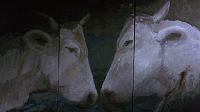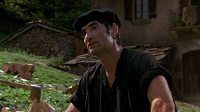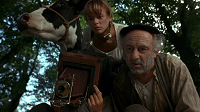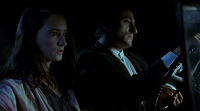Vacas
05/13/2012
Spain / 1992 / Spanish
Directed by Julio Médem
With Carmelo Gómez, Ana Torrent, Kandido Uranga
 An axe-wielding man stands in the middle of a glade, athletically hacking away at the tree stump on which he stands, his platform dwindling with each furious stroke. The wedges of wood litter the ground, covering up the fern blanket beneath him. His solitude and absorption are strangely menacing in themselves, his concentrated, up and down motion without an obvious point to it, besides to destroy the platform beneath him.
An axe-wielding man stands in the middle of a glade, athletically hacking away at the tree stump on which he stands, his platform dwindling with each furious stroke. The wedges of wood litter the ground, covering up the fern blanket beneath him. His solitude and absorption are strangely menacing in themselves, his concentrated, up and down motion without an obvious point to it, besides to destroy the platform beneath him.
It is 1875, and the woodcutter, Manuel Irigibel, subsequently finds himself thrown onto the field of battle. There he encounters Carmelo, a new father and member of a neighboring family. Manuel seems reluctant to pass on tidings of the man’s newborn son, either because he senses that his neighbor is doomed never to see the boy, or because of some nagging, clan-based repulsion. Their reunion is cut short when Carmelo falls back into the trench with a bullet wound. Manuel lays low, covering himself with blood from the man’s coursing neck in order to pass as one of the dead and be carted away to safety.
Julio Médem’s Vacas traces the intertwined family sagas of the two woodsmen following this event, the psychic effects that it has, which threaten to unhinge the lives they lead in the Basque countryside. After that bloody scene on the front, the story leaps ahead a generation. Manuel has made it to old age, still disabled from the war and seemingly out of touch with reality. His grown son, Ignacio, is quite handy with the axe himself, supporting his sisters with the money he wins in tree-cutting competitions. In a rambling house near to them live the children of Carmelo: thirty-year-old Juan and his sister Catalina, isolated by a mysterious enmity for the Irigibels that they have more or less inherited.
Ignacio and Catalina share a slowly burning attraction to one another, an illicit bond that carries across the fields and woods. But they are cautious not to approach one another, aware of the watchful eyes of their respective families. The young man winds up in competition with Catalina’s controlling brother, Juan, who is now the head of the rival household. The person who maintains good relations with both clans is the red-haired Ilegorri, also the only one remaining in the story who may have borne witness (as a young boy assisting the soldiers) to Manuel’s cowardice in the trenches. He steps in as the fixer in the log-cutting competition between the two men, in order to ride the coattails of whoever got the victory.
As it happens, Juan is the one who hangs his head in shame when Ignacio defeats him, and it is the other man who goes on to garner fame and fortune for his physical feats. To add insult to injury, Catalina has become mesmerized by her taboo crush, unable to resist his quiet and easygoing virility. One day they cross paths in the glade adjoining the fields – this is, in all probability their first time together – and he forcefully ravages her on the forest floor.
 Ten years on and the Great War is ravaging places that couldn’t feel more distant. The people talk about current events but are only ever brought into the fold when Spain is fighting with itself. Catalina now has a ten-year-old son, Peru, who lives with her and Juan. One of Ignacio’s younger sisters, Cristina, is a sunny adolescent who spends much of her time accompanying her dotty father in his world of spirits and superstition. She has a close friendship with Peru, oblivious to the differences in their two families, or perhaps slightly aware that he is not entirely of the rival clan. Meanwhile Ignacio, now quite prosperous and worldly, continues to meet with Catalina, picking her up for rides through the night in his motorcar.
Ten years on and the Great War is ravaging places that couldn’t feel more distant. The people talk about current events but are only ever brought into the fold when Spain is fighting with itself. Catalina now has a ten-year-old son, Peru, who lives with her and Juan. One of Ignacio’s younger sisters, Cristina, is a sunny adolescent who spends much of her time accompanying her dotty father in his world of spirits and superstition. She has a close friendship with Peru, oblivious to the differences in their two families, or perhaps slightly aware that he is not entirely of the rival clan. Meanwhile Ignacio, now quite prosperous and worldly, continues to meet with Catalina, picking her up for rides through the night in his motorcar.
The love between the two of them doesn’t feel forbidden so much as overdetermined. It is both responsible for Juan’s insanity and a result of it, being pushed forward by his attempts to control his sister. Their meetings are not a refutation of the feud but a realization, introducing the biggest fissure they could manage. Since the sanctity of their family boundaries have already been trespassed, Juan is unable to cope with the fact of their relationship. He half-accepts Peru as her son, but also abuses her physically and emotionally. On one night he crawls into her bed and tries to sleep with her, suggesting that incest and violence has long been part of their relationship as siblings.
Retreating from the stifling atmosphere of his home and the scars wrought by his uncle’s imbalance, Peru spends his youth going on expeditions with old Manuel and the peach-fuzzed Cristina, and finding solace in the eyepiece of a camera, one of the many strange wonders that Ignacio has accrued over the years. He returns to the village as a grown man, after years spent abroad being educated in America. His mother has long since disappeared, either killed by her brother or swept away by her lover. Peru doesn’t know, and the two possibilities must be disturbingly conflated in his mind. Juan is nowhere in sight. It is the Spanish Civil war and the Fascist soldiers are rounding up Basque men and women suspected of being allied with the Communists.
 Peru has never let go of his bond with Cristina, and they have spent their time apart corresponding by letters. He has come as a war photographer, but with no idea just how close he will get to the carnage that is sweeping the land. Life has moved on, and Cristina has moved on, engaged to the son of Ilegorri. The two childhood friends are now worlds apart. What has remained the same – the expansive fields, that eternal glade with a bottomless pit at its center, the implacable family vendettas – now seem flattened into a bucolic memory, mattes behind the tall and obscuring grass that crawls with casually barbarous soldiers.
Peru has never let go of his bond with Cristina, and they have spent their time apart corresponding by letters. He has come as a war photographer, but with no idea just how close he will get to the carnage that is sweeping the land. Life has moved on, and Cristina has moved on, engaged to the son of Ilegorri. The two childhood friends are now worlds apart. What has remained the same – the expansive fields, that eternal glade with a bottomless pit at its center, the implacable family vendettas – now seem flattened into a bucolic memory, mattes behind the tall and obscuring grass that crawls with casually barbarous soldiers.
There’s nothing of a background about this landscape – it’s noisy, oppressive, ever in motion, full of murder and decay, sprouting people who gnarl and grow old. Bulbous hay wains groan palpably, cows break loud wind, the bosky ferns rustle as though being tramped through by ghosts. Everything is beautiful, innocent, and terrifying. Even the blades of grass emit a seething clatter not unlike a bamboo forest. The glade shifts in form and function, reflecting an illusory inner landscape depending on whoever inhabits it. While it is a vampiric, sexual trap for Catalina, it effortlessly becomes an arena for young Peru’s nightmares of hidden assassins and pools of what he imagines to be his mother’s viscera. The camera motion never settles in a continuous mode but disrupts the peace with internalized points of view and tracking shots that move away from the action, lithely drawing out dissonant instincts. Stillness is never just that, and there is always a pressing weight, an urgent unsteadiness, that fills its open spaces.
Widely-splayed angles and sudden upward-cranes almost prepare us for some glossy visual effect, something to divorce us further from what we are seeing, but this never come. Médem’s visuals are polished, but he retains the blunt sensibilities of a protean fabulist, never compromising an intrinsic feel for the bestial and irrational, the grim atavism at the core of our emotions. Here, fairytale melodrama is whittled down by fear, sharp and senseless as a makeshift arrow. The film represents such a magnificently swollen depiction of rural life, not just for the sensory aspects of it, but also the ways in which it resounds in the memory. Repressed and flavorless lives are imbued with a metallic tinge that lasts forever, even into generations beyond. This is the darkly sanguine view on Spanish history, shot through with claret and hollow skulls, ghostly fifes swelling on the soundtrack.
And who knows bloodshed better than the cows? They wend their way through former battlefields, linger among the forest’s secrets, find themselves dismembered as sacrifices on an altar to fate. None of it makes any sense. Manuel, the character we are meant to see as being responsible for the ripples of lunacy and control that shoot through the two families, walks among them as an incoherent innocent, the least engaged with what happens to them. He makes art brut paintings of the cows on wood panels, finishing them off with faintly trickling puncture wounds. With the help of Cristina and the other children, he fashions a life-sized male figure from leaves and vines, giving it a real scythe to hold and be spun by the wind, and tops it with the red beret of a Carlist soldier. Locked forever with one solitary function, this unsettling burry-man also has a cowbell, the clarion of bucolic innocence, tied to its neck. Is it meant to stand for Manuel, idealized as a young soldier plucked from the ground, vertical strength polluted by the cruel forward motion of the bayonet?
Médem imagines the family portrait, ostensibly functioning as a showcase of material wealth (the whole family and their belongings arrayed in front of the farmstead) as being also an externalizing of their true feelings. Posing for the photograph, Ignacio holds the axe, tool of his success, dangerously over his eldest sister’s head. She abruptly walks to the other end of the frame, while Manuel stands atop a tree stump as a faded sketch of what he once was.
The manner in which contemporary Spanish cinema deals with the nation’s history is frequently characterized by unremitting brutality, which may be born of a certain historical inevitability. While the violence in the films of Agustí Villaronga, Alejandro Amenábar or Álex de Iglesia is certainly as overwrought as any that may come into vogue in America or elsewhere in Europe, it is also more studied, more troublingly endemic, more curdled, so to speak, than any torture-comedy could ever hope for, let alone desire. The soul-searching always goes straight to the entrails, and blood, either shed or deified, forms the path back through the last century.
 What does this have to do with Médem’s work? Well, the passing resemblance is significant, because Vacas also differs dramatically from its nearest cousins, dwelling much more on decay and its role in birth, draining warfare of any thrill or agony, resting its gaze on the thorny, twisted heap of psychic conditioning underlying it. Médem’s film is bloody but not bloody-minded, its complexity justifying its hinging on violence, which it seldom shows but which seems to gurgle right beneath every possible surface. While the images possess a degree of arousal, the tumescence surrounding the death/sex fusion, these connections are never fully consummated. Decomposition is the focus, as well as the fact of piled bodies, as a naked Manuel, having escaped the battlefield, finds himself reborn from out of their contorted limbs.
What does this have to do with Médem’s work? Well, the passing resemblance is significant, because Vacas also differs dramatically from its nearest cousins, dwelling much more on decay and its role in birth, draining warfare of any thrill or agony, resting its gaze on the thorny, twisted heap of psychic conditioning underlying it. Médem’s film is bloody but not bloody-minded, its complexity justifying its hinging on violence, which it seldom shows but which seems to gurgle right beneath every possible surface. While the images possess a degree of arousal, the tumescence surrounding the death/sex fusion, these connections are never fully consummated. Decomposition is the focus, as well as the fact of piled bodies, as a naked Manuel, having escaped the battlefield, finds himself reborn from out of their contorted limbs.
The internecine conflicts that periodically wrack the tragic place seem as though they live on within narrowing spaces, like a marble circulating down a conical chute until it spins madly and eternally into the center. One must never forget that brutality and cowardice, even when played out on a national scale, are also taking place within each individual that takes part in them.
While, taken together as aggregate parts, the film seems confused, piling on symbols without giving much sense for their interplay, this overall confusion is as intimately related to its material as costume or mise-en-scene. That feeling is, if not intentional, at least quite apt for the conditions of Basque identity trying to attain solidity in the context of Spain, and rural people trying to reconcile total war with their customs and notions of masculinity. Were it not so immersive, it would feel as though the film were playing out entirely on a plane of exaggerated but inept metaphors. We feel like we are meant to ponder on them, but they are meant more as tunnels of interpretation, like the camera that Peru uses to observe Cristina or the impassive, fly-swarmed eye of the cow.
Two of the film’s characteristics rescue it from becoming unbearably muddled. For one, it stays shy of going on for an epic length, even while it strides across time periods. Also, the periodic intertitles denoting the passage of time help us sort out who is who, as actors resurface in different roles through the generations. Carmelo Gómez has three roles throughout the film (as Irigibel I, Irigibel II, and a grown-up Peru), while Kandido Uranga plays Carmelo and subsequently Juan. Meanwhile Emma Suarez, already in her late twenties at the time of filming, is Cristina from adolescence up to adulthood. Each time period is introduced like a fable or short story, and the jumps ahead in chronology happen with an abruptness that resists any sort of closure.
The similarities between the time frames of the film’s segments demand some textual guidance (the intertitles), and they also create the weird feeling of insularity and cruel, inescapable continuity that bind everything together. Each successive generation is like an overlaid decalcomania portrait of its predecessors and their actions, implacable marks of past animosity. In the Basque country of the film, bad feelings do not pass as water under the bridge, but remain, growing ever deeper and more stagnant. It takes a war to set things in motion, to tear the collective bonds that people share asunder. And then it can, just as violently, push the people back together, strength filling in the cracks left by weakness.
Remember Ana Torrent from Spirit of the Beehive and Cria Cuervos.
Yes, for sure! Although I think my favorite (childhood) performance of hers was in Armiñán’s ‘The Nest’.